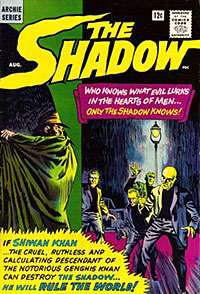 After the demise of Street & Smith‘s comic-book line, The Shadow would not return to comics until 1964, this time from Archie Comics.
After the demise of Street & Smith‘s comic-book line, The Shadow would not return to comics until 1964, this time from Archie Comics.
Yes, the publisher of the popular teen characters of Archie, Betty, Veronica, Jughead and all the rest. Published at the same time as Belmont Books was doing the new Shadow novels, Archie probably got the rights because both Archie and Belmont were owned by the same company. And it appears that some of the same ideas carried over.
This comic-book version is universally viewed as the worse comic-book version of The Shadow. It lasted only eight issues over the course of a year (August 1964 to September 1965). It also served as a bridge from their superheroes comics of the “Archie Adventure Series” period to the more campy “Mighty Comics Group.”
The Shadow actually went through a few changes during this series.
In the first issue, we meet a blond, eyeglass wearing billionaire Lamont Cranston, the world’s greatest secret agent. The Shadow is just a disguise of his. Other changes include Margo Lane as his secretary, Shrevvy as his chauffeur, and Weston has his CIA contact. Shiwan Khan is an enemy agent Cranston faces.
The cover is nice, but the interior does not live up to it. This issue has a second story, plus a text story giving the “origin” of The Shadow that seems more like the Batman (Cranston become a billionaire in college when his parents die, he travels to Cairo and learns hypnotism, etc.) that runs through all the issues. I don’t think the text stories were credited, and I’m not sure who wrote them.
The second issue starts the transformation of The Shadow into a spandex-wearing superhero. The cover shows The Shadow in a blue-and-green outfit that exposes his hair, but the interior stories follows what we saw in the first issue. This issue The Shadow again goes up against Shiwan Khan.
The third issue now gives us a black-haired Cranston, who wears the green-and-blue spandex outfit, going up again against Shiwan Khan. The artwork is now by Paul Reinstein instead of John Rosenberger (who did the first two issues).
The fourth issue introduces another new change. Instead of Robert Bernstein writing the title, it’s Jerry Siegel, co-creator of Superman. But this is not something to cheer, as he is usually credited (or blamed?) for camping up Archie’s Mighty Comics superheroes. This time we have a new villain, the sort-of Nazi Dr. Demon, who gives both The Shadow and Shiwan a run for their money.
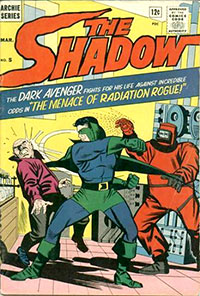 The fifth issue now adds a new element to this Shadow. Each morning he works out in a sort of “Danger Room” to hone his skills, just like Marvel’s X-Men. Shiwan Khan is back, this time sending another villain after The Shadow: the Radioactive Rogue. It also seems that The Shadow is an agent of C.H.I.E.F., rather then the CIA. Now, the Belmont paperbacks had The Shadow as a spy, but I have no idea if this was the same group. I don’t think they ever told what it stood for.
The fifth issue now adds a new element to this Shadow. Each morning he works out in a sort of “Danger Room” to hone his skills, just like Marvel’s X-Men. Shiwan Khan is back, this time sending another villain after The Shadow: the Radioactive Rogue. It also seems that The Shadow is an agent of C.H.I.E.F., rather then the CIA. Now, the Belmont paperbacks had The Shadow as a spy, but I have no idea if this was the same group. I don’t think they ever told what it stood for.
The sixth issue again has Shiwan Khan, this time allied with Attila the Hunter (no, that’s not a typo). We learn that as Shiwan is a descendant of Genghis, Attila is a descendant of Attila the Hun. The seventh issue had Khan create The Brute to go up against The Shadow. The eighth issue has Elasto and the Dimensionoid, as well as the return of a couple of other villains. And Shiwan Khan is not in sight!
Overall, both writing and artwork is pretty poor in this series. This posting doesn’t do a good job of explaining just how awful it all is. In part because someone else already did a much better job at it. But basically I think the problem is trying to make The Shadow something he’s not. Due to the spy crazy of the time, they tried to make The Shadow a super-spy, like the Belmont Shadows. But why? If he’s a spy, what is the purpose of the superhero outfit, which seems to try to get traction from the camp hero phase. It’s like a bad attempt at crossing over the “Batman” TV show with, say, “The Man from U.N.C.L.E.” or James Bond. It just doesn’t work.
Michael Hoskin‘s blog Section 244 did a 12-part review of all the stories in this series, with an additional wrap up of it. You can read the first of a 12-episode review of the series here.
Having read some of the issues myself, I can say that whatever can be said of subsequent series, none have been as bad. Heck, even the author of Section 244 stated that this series was a perfect (perfect?) example of how to do a bad comic book. I’d have to agree.

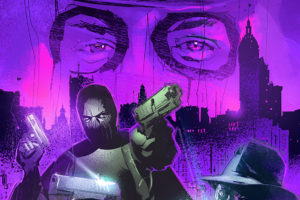
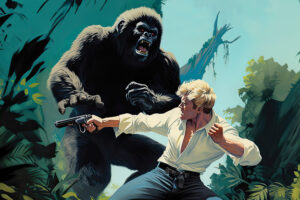
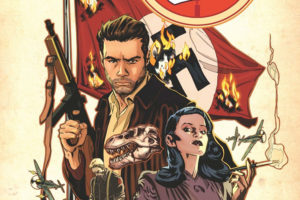
Your comments